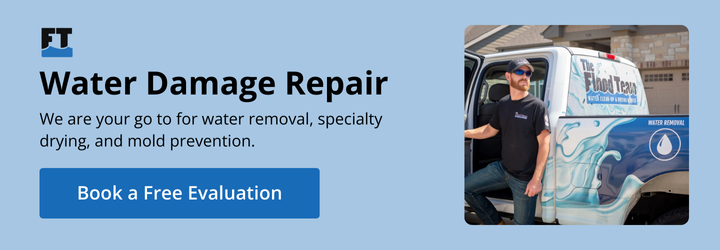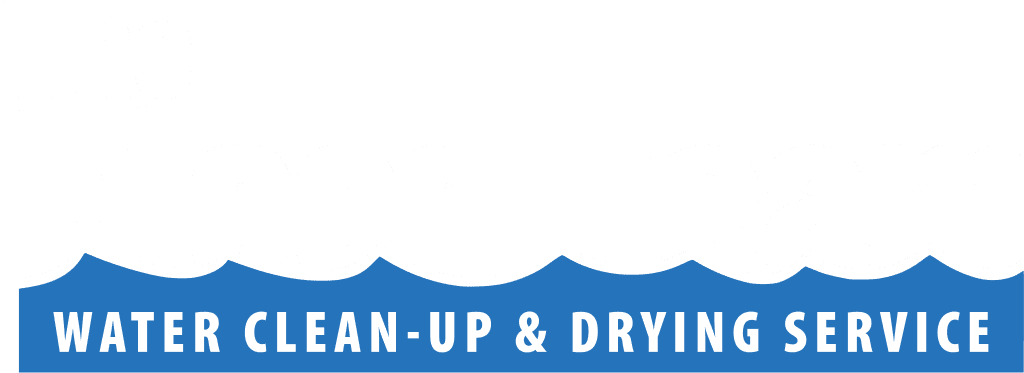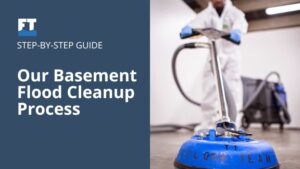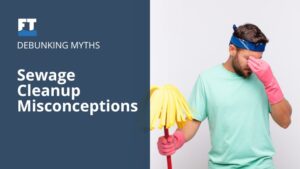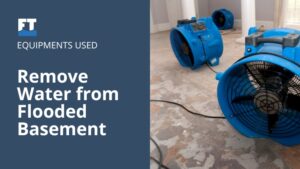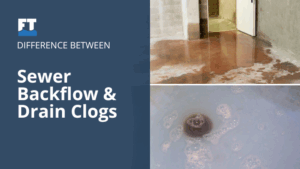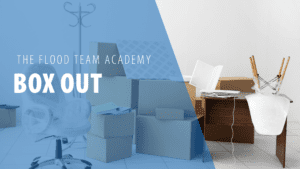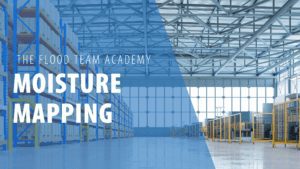The Ultimate Water Damage Repair Guide
We know water is vital to our survival. Three days is the most any person can live before experiencing life-threatening dehydration. Still, water can also harm our homes or workspaces in emergency situations.
Water damage is the type of water you can certainly live without.
No one can live with water intruding into their personal or commercial space, causing soggy floors, structural decay, ruined belongings, mold, health issues, and more. The Flood Team is your best bet when things get wet so you can live without water’s damaging effects. Call us 24/7, and let us get to work for you as your water damage repair experts.
What is Water Damage?
Water damage is water that negatively impacts the inside of your home or commercial space. It occurs after uncontrolled water, water vapor, or moisture intrudes into locations for which it was unintended. Subfloor damage, drenched drywall, destroyed belongings, structural damage, contamination, and mold damage can range in severity and prove very costly.
To make matters worse, water damage can be both seen and unseen. Upon intruding into your property, it can quickly spread, even into hidden crevices, making it difficult to detect without special equipment. This may intensify destruction to flooring, walls, ceiling, belongings, and so much more. Contacting a water damage repair specialist like The Flood Team ensures water does not go undetected. Besides, hidden water can cause secondary damage, such as rapid mold growth in as little as 48 hours, which can be hazardous to people and pets. (More on that later.) Water damage repair specialists are equipped with moisture meters to detect the presence of water in hard-to-reach places to restore your property and peace of mind.
Water Damage Categories
It’s important to note that depending on the water category, the damage may become permanent and seriously harmful to your health. What is water category? Well, it’s simpler than you may think:
There are three categories of water identified by their origin and not necessarily their color:
Category 1 is “clean water” from water lines, such as leaky water pipes. It is potentially the least hazardous category because it holds the least amount of contaminants, but even that can change in as little as 72 hours.
Category 2 water is considered “gray water” because it is slightly dirty water from appliances such as dishwashers and washing machines.
Category 3 is the most contaminated water and poses the most immediate health threat. It is called “black water” and often comes from sewer backflow or overflowing toilets.
The following is a simple guide to help you determine the water category:
Category 1 – Water from a Fresh Source
- Pipe break
- Water heater
- Sink overflow
- Water line
Category 2 – Semi-Contaminated Water
- Groundwater
- Seepage
- Sump pump failure
- Broken aquarium
Category 3 – Highly-Contaminated Water
- Sewer Backup
- Drain Overflow
- Rainwater Flooding (Water that comes in from the street level)
Common Water Damage Causes
Now that we’ve defined water damage, how about common causes? Some common causes include broken appliances, such as dishwasher leaks and washing machine overflows. Broken or leaky pipes can also be the culprit. Heavy rainfall seeping into your property, sewer backups, clogged toilets, discharged commercial water sprinkler alarms, and a leaky roof, window, and door are a few more common sources of water intrusion and damage.
Sometimes the cause is not easily recognizable. In this instance, you are highly recommended to contact a plumber, drain inspector, or waterproofing professional to diagnose and address the root issue. To address water damage, a reputable water restoration company like The Flood Team will not only diagnose the problem but also dry, clean, and restore your property and peace of mind.
What is Water Damage Repair?
Water damage repair services are essential for restoring your home or commercial space effectively and quickly. After assessing the damage, the main objective is to stop the source of uncontrolled water and then begin drying the affected areas. Cleaning, sanitizing, and restoring your property are next in the order of business. You can take steps on your own to begin water removal or repairs. However, some areas may appear dry to the touch while still harboring unwanted water. This undetected water will pack a hard punch as swelling or secondary damage, such as mold, sets in. For greater peace of mind and safety, it is highly recommended that you contact a trained professional for your water damage repair needs.
Upon arrival, a water damage repair professional will assess the water emergency and provide a plan for drying, cleaning, and restoring your property rapidly. Water damage repair professionals like The Flood Team will arrive fully stocked with state-of-the-art technologies to detect water in hard-to-reach places. We then aim to dry all affected materials as quickly as possible.
Water damage repair often includes cleaning and sanitizing the contents and materials in your home or business, depending on the water category and other factors. Cleaning can also involve mold removal and mitigation, common when moisture levels rise above the 30-50% norm within homes for several days after water exposure. A professional will also monitor moisture levels to ensure all materials are dry to industry standards and their plan of action is effective at water removal and moisture reduction.
Time is a Top Priority
Water is Invasive
Time is top of mind when dealing with a water emergency because of the nature of water. It is sneaky, seeping through tiny crevices and cracks into areas or rooms easily overlooked. These include closets, under cabinets, stair cavities, and other hidden or hard-to-reach spaces. Water also quickly absorbs up walls and other materials. While most materials can be restored after initial contact with water, long-term water contact will cause nearly all materials to break down, making finding ALL wet or moist areas essential. Structural materials and valued items can become permanently damaged from prolonged contact with water or moisture, causing swelling, staining, rotting, and even hazardous mold growth.
Mold is Menacing
Speaking of mold, time is also of the essence when there is potential for mold growth. Though mold spores are nearly everywhere indoors and outdoors, they require special conditions to grow and thrive. Moist and humid conditions are the perfect breeding ground for mold growth–common conditions in the aftermath of water emergencies. Mold can spread quickly in as little as 72 hours after water intrudes into your property. Mold’s impact on home and commercial materials is not the only issue at stake. It harms health, causing many adverse health effects such as headaches, lung irritation, wheezing, sore throat, coughing, skin rashes, eye irritation, and more. Quickly addressing water damage is the primary way to avoid the menacing impact of mold’s secondary damage to your property.
Water Category Becomes More Critical With Time
Additionally, as previously discussed, there are three categories of water, all of which can create more critical conditions with time. Category 1, “clean water,” is considered the least hazardous to health and belongings. However, the longer water sits, the more dangerous it becomes. If left untreated, each category will worsen significantly over time. Depending on the water source and how long it has been standing, water can be incrementally more contaminated and lead to adverse effects on the contents of your home or workspace and the people who come in contact with the contaminated materials. This occurs because stagnant water quickly duplicates bacteria, contaminating everything it touches. This may also make it impossible to clean and sanitize specific materials due to water contaminants properly. In short, after coming in contact with Category 1 water, salvageable materials may not remain so in as little as 72 hours. In essence, time is critical no matter the category of water involved.
Act fast because water damage worsens with time, increasing costs and damage to your property! Calling The Flood Team, even before contacting your insurance agent, can have our remediation specialist out in no time to assess your damage, address your emergency, and file an insurance claim for you when necessary.
Steps To Take When You Notice Water Damage
When you first detect water damage, here are some steps you can take to ensure you are safe and things do not become worse over a short period.
Step 1 – Identify the Cause or Source of Water Damage
If possible, identifying the source of water intrusion is a significant first step. In some instances, you can take immediate, sometimes temporary, action to stop water intrusion and additional damage, such as turning off the water in the property if there is a leaky pipe. This can mitigate damage as you contact a reputable water damage repair expert such as The Flood Team to dry, clean, and restore.
Upon discovering the cause of water damage, taking photos is beneficial to monitor the progression of damage. Contact a water remediation professional to investigate and appropriately address your emergency if the source is not recognizable.
Step 2 – Determine the Water Category
After identifying the source, determining the water category is next. Since the water category involves the level of contamination in water, knowing this will help you decide whether it is safe to enter the water without personal protective equipment (PPE). PPE is worn to reduce exposure to hazards that can cause illness or injuries. It may include electrically insulated, watertight boots. Other shoes or clothing should not be worn in category 3 water because they will transfer contamination and will not prevent electrical shock. Hip waders may also be required depending on how high the standing water on your property is.
Knowing the water category will also give you a quick estimate of what wet belongings are salvageable. Depending on the category, some building materials can be dried and saved. In contrast, other materials are recommended for disposal because they have absorbed contaminated water that cannot be cleaned and sanitized.
Step 3 – Contact a Water Damage Repair Expert Immediately
While there are things you can do to help resolve the emergency on your own, it is not advisable. Given the time-sensitive nature of water damage, the sneaky nature of water seeping into hard-to-reach places, the potential for water to go undetected without a specialized moisture meter, and the possibility of contamination and mold growth should water remain undetected. Water remediation professionals are equipped and trained to resolve water damage in your home or business as quickly as possible. A reputable remediation company like The Flood Team has more than 30 years of effectively addressing water damage across the US. We provide a free evaluation and arrive equipped, trained, and highly certified to handle your water damage emergency quickly.
Call The Flood Team even before contacting your insurance so our specialists can serve as your emergency ally as we file a claim on your behalf if one is necessary. We will call the insurance company on your behalf and have seamless processes to help you with your claim. As a complimentary service, you and your insurance company will have full access through The Flood Team proprietary app to your essential documents, water remediation process, and progress, all in one place. Our app houses invoices, receipts, photos, moisture readings, and any other documentation needed for your insurance claim process.
So act fast, call the Flood Team FIRST, and let us put our experience and expertise to work for you!
How to Prevent Future Water Damage
Following water damage repairs, no one wants to experience another water emergency if at all avoidable. Again, it’s something we all can live without! The good news is there are things you can do to help prevent water intrusion and damage in the future.
Clearing Gutters and Downspouts
Clogged or inefficient gutters are a primary reason for water intrusion from the exterior of your home or business. Clearing out gutters twice a year can prevent blockage to water flowing away from your roof and foundation. Seepage is a known cause of interior flooding. It happens when water accumulates around the exterior walls of a home, and gravitational pressures force it to seep into walls, cracks, and crevices, creating a flood or damage to the foundation. Cleaning out downspouts help to ensure water moves away from your home, so it does not pool near your home’s exterior walls.
Waterproofing Structures
Overtime seal and caulking in showers and tubs may deteriorate. Inspect them to ensure they are watertight and replace and reseal them when necessary.
Become Familiar With Water Main
Many homeowners may not know the importance of becoming familiar with their water main until it is too late. Plumbing experts say that shutting off the water main may be one of the most important things you can do to stop intrusive water flow from pipes throughout your home or business. The water main is a pipe that supplies clean water to your home or business from your city’s water utility. It is usually underground below your property but can also be located in a below-grade basement or elsewhere. The water main location is not universal, so it may take time to find it in an emergency. Knowing its location and how to turn it off in an emergency can save you thousands in water damage.
Maintain Appliances
Appliance malfunctions are the most common cause of interior water damage. According to manufacturer guidelines, you should check appliances with a water hose yearly for leaks. Dishwashers, washing machines, and refrigerator hoses should especially undergo regular inspection as they usually have a 5-year lifespan before defects are more likely. Replace defective hoses immediately or every five to seven years to decrease the chance of cracks and tears. Some may also wish to purchase a water leak monitor and shut-off system. It alerts you to any leakage issues before it’s too late.
Promptly Address Leaks
If there is any evidence of a leak, take it seriously. Look into the cause promptly and make or schedule necessary repairs with a professional. If left unaddressed, issues involving mold, dry rot, mildew, or structural damage are more likely.
Standard homeowner’s insurance typically does not cover water damage due to neglect or lack of regular or timely maintenance, so addressing damage immediately reduces water damage and saves you money and headache.
Check Water Pressure
Water pressure that is set too high may cause pipes and hoses to fail under pressure over time. For this reason, investing in a water pressure gauge is wise. Attach it to any outside faucets and run water at full capacity. The gauge will then inform you of your home’s water pressure.
A 40–70 psi water pressure is typical for residential water systems. If it exceeds 100 psi, installing a pressure regulator will prevent pipe or hose damage due to excessive pressure. An emergency pressure release valve will protect against pipes nursing due to freezing weather.
Prevent Basement Seepage
While 14.6 million homes are likely to have flood issues, 98 percent of basements experience water damage. Therefore, inspecting and resealing your basement for cracks in building foundations and floor slabs is imperative. If, after heavy rainfall, water seeps into your basement when previously there was no issue, this indicates that your basement is no longer adequately waterproof. Deterioration to waterproofing material happens over time, so keeping an eye out is necessary. Painting or repainting areas where water is likely to intrude is a great preventative measure.
Consider Preventative Landscaping
When water flows towards a home or business, the chances of seepage into your property are increased. This is especially noticeable following heavy rainfall. When saturated soil swells, creating a cavity or separation between the landscape and your home. This cavity can serve as a channel where rainwater can flow toward your property, moving downward along the foundation walls. If cracks have formed along the water’s path, water will likely seep into your home.
Should a water disaster strike despite your best preventive efforts, trust The Flood Team’s water damage repair experts to resolve it quickly. Water damage. It’s something we CAN’T live with and CAN certainly live without though statistics show 14,000 new water damage emergencies on any given day; it can happen to anyone. It can happen to you or someone you know. So if or when it does, The Flood Team is your best bet when things get wet. Let us help you live without water’s damaging effects today.
